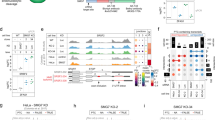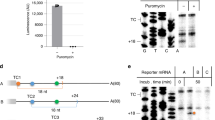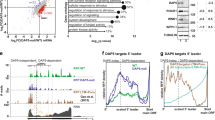Abstract
Nonsense-mediated mRNA decay (NMD) generally eliminates messenger RNAs that prematurely terminate translation and occurs in all eukaryotes that have been studied, although with mechanistic variations. In mammals, NMD seems to be restricted to newly synthesized mRNA that is bound by the cap-binding heterodimer CBP80-CBP20 (CBP80/20) and typically has at least one exon junction complex (EJC) situated downstream of the nonsense codon and added post-splicing. However, mammalian NMD can also target spliced mRNA lacking an EJC downstream of the nonsense codon. Here we provide evidence that this additional pathway, known as failsafe NMD, likewise seems to be restricted to CBP80/20-bound mRNA and does not detectably target its subsequently remodeled product, eIF4E-bound mRNA. Our studies, including analyses of factor dependence, reveal important shared features of the two mammalian-cell NMD pathways as well as fundamental differences between NMD in mammals and Saccharomyces cerevisiae.
This is a preview of subscription content, access via your institution
Access options
Subscribe to this journal
Receive 12 print issues and online access
$209.00 per year
only $17.42 per issue
Buy this article
- Purchase on SpringerLink
- Instant access to full article PDF
Prices may be subject to local taxes which are calculated during checkout




Similar content being viewed by others
References
Nagy, E. & Maquat, L.E. A rule for termination-codon position within intron-containing genes: when nonsense affects RNA abundance. Trends Biochem. Sci. 23, 198–199 (1998).
Zhang, J., Sun, X., Qian, Y. & Maquat, L.E. Intron function in the nonsense-mediated decay of beta-globin mRNA: indications that pre-mRNA splicing in the nucleus can influence mRNA translation in the cytoplasm. RNA 4, 801–815 (1998).
Thermann, R. et al. Binary specification of nonsense codons by splicing and cytoplasmic translation. EMBO J. 17, 3484–3494 (1998).
Tange, T.O., Nott, A. & Moore, M.J. The ever-increasing complexities of the exon junction complex. Curr. Opin. Cell Biol. 16, 279–284 (2004).
Neu-Yilik, G. et al. Splicing and 3′ end formation in the definition of nonsense-mediated decay-competent human beta-globin mRNPs. EMBO J. 20, 532–540 (2001).
Bühler, M., Steiner, S., Mohn, F., Paillusson, A. & Mühlemann, O. EJC-independent degradation of nonsense immunoglobulin-mu mRNA depends on 3′ UTR length. Nat. Struct. Mol. Biol. 13, 462–464 (2006).
Cheng, J., Belgrader, P., Zhou, X. & Maquat, L.E. Introns are cis effectors of the nonsense-codon-mediated reduction in nuclear mRNA abundance. Mol. Cell. Biol. 14, 6317–6325 (1994).
Wang, J., Gudikote, J.P., Olivas, O.R. & Wilkinson, M.F. Boundary-independent polar nonsense-mediated decay. EMBO Rep. 3, 274–279 (2002).
Zhang, J., Sun, X., Qian, Y., LaDuca, J.P. & Maquat, L.E. At least one intron is required for the nonsense-mediated decay of triosephosphate isomerase mRNA: a possible link between nuclear splicing and cytoplasmic translation. Mol. Cell. Biol. 18, 5272–5283 (1998).
Moriarty, P.M., Reddy, C.C. & Maquat, L.E. The presence of an intron within the rat gene for selenium-dependent glutathione peroxidase 1 is not required to protect nuclear RNA from UGA-mediated decay. RNA 3, 1369–1373 (1997).
Amrani, N. et al. A faux 3′-UTR promotes aberrant termination and triggers nonsense-mediated mRNA decay. Nature 432, 112–118 (2004).
Ishigaki, Y., Li, X., Serin, G. & Maquat, L.E. Evidence for a pioneer round of mRNA translation: mRNAs subject to nonsense-mediated decay in mammalian cells are bound by CBP80 and CBP20. Cell 106, 607–617 (2001).
Hosoda, N., Kim, Y.K., Lejeune, F. & Maquat, L.E. CBP80 promotes interaction of Upf1 with Upf2 during nonsense-mediated mRNA decay in mammalian cells. Nat. Struct. Mol. Biol. 12, 893–901 (2005).
Lejeune, F., Ishigaki, Y., Li, X. & Maquat, L.E. The exon junction complex is detected on CBP80-bound but not eIF4E-bound mRNA in mammalian cells: dynamics of mRNP remodeling. EMBO J. 21, 3536–3545 (2002).
Das, B., Guo, Z., Russo, P., Chartrand, P. & Sherman, F. The role of nuclear cap binding protein Cbc1p of yeast in mRNA termination and degradation. Mol. Cell. Biol. 20, 2827–2838 (2000).
Gao, Q., Das, B., Sherman, F. & Maquat, L.E. Cap-binding protein 1-mediated and eukaryotic translation initiation factor 4E-mediated pioneer rounds of translation in yeast. Proc. Natl. Acad. Sci. USA 102, 4258–4263 (2005).
Holbrook, J.A., Neu-Yilik, G., Hentze, M.W. & Kulozik, A.E. Nonsense-mediated decay approaches the clinic. Nat. Genet. 36, 801–808 (2004).
Nesic, D. & Maquat, L.E. Upstream introns influence the efficiency of final intron removal and RNA 3′-end formation. Genes Dev. 8, 363–375 (1994).
Kugler, W., Enssle, J., Hentze, M.W. & Kulozik, A.E. Nuclear degradation of nonsense mutated beta-globin mRNA: a post-transcriptional mechanism to protect heterozygotes from severe clinical manifestations of beta-thalassemia? Nucleic Acids Res. 23, 413–418 (1995).
Gingras, A.C., Kennedy, S.G., O'Leary, M.A., Sonenberg, N. & Hay, N. 4E–BP1, a repressor of mRNA translation, is phosphorylated and inactivated by the Akt(PKB) signaling pathway. Genes Dev. 12, 502–513 (1998).
Chiu, S.Y., Lejeune, F., Ranganathan, A.C. & Maquat, L.E. The pioneer translation initiation complex is functionally distinct from but structurally overlaps with the steady-state translation initiation complex. Genes Dev. 18, 745–754 (2004).
Sun, X., Perlick, H.A., Dietz, H.C. & Maquat, L.E. A mutated human homologue to yeast Upf1 protein has a dominant-negative effect on the decay of nonsense-containing mRNAs in mammalian cells. Proc. Natl. Acad. Sci. USA 95, 10009–10014 (1998).
Kim, Y.K., Furic, L., Desgroseillers, L. & Maquat, L.E. Mammalian Staufen1 recruits Upf1 to specific mRNA 3′UTRs so as to elicit mRNA decay. Cell 120, 195–208 (2005).
Gehring, N.H., Neu-Yilik, G., Schell, T., Hentze, M.W. & Kulozik, A.E. Y14 and hUpf3b form an NMD-activating complex. Mol. Cell 11, 939–949 (2003).
Gatfield, D., Unterholzner, L., Ciccarelli, F.D., Bork, P. & Izaurralde, E. Nonsense-mediated mRNA decay in Drosophila: at the intersection of the yeast and mammalian pathways. EMBO J. 22, 3960–3970 (2003).
Kunz, J.B., Neu-Yilik, G., Hentze, M.W., Kulozik, A.E. & Gehring, N.H. Functions of hUpf3a and hUpf3b in nonsense-mediated mRNA decay and translation. RNA 12, 1015–1022 (2006).
Shibuya, T., Tange, T.O., Sonenberg, N. & Moore, M.J. eIF4AIII binds spliced mRNA in the exon junction complex and is essential for nonsense-mediated decay. Nat. Struct. Mol. Biol. 11, 346–351 (2004).
Chan, W.K. et al. An alternative branch of the nonsense-mediated decay pathway. EMBO J. 26, 1820–1830 (2007).
Gehring, N.H. et al. Exon-junction complex components specify distinct routes of nonsense-mediated mRNA decay with differential cofactor requirements. Mol. Cell 20, 65–75 (2005).
Behm-Ansmant, I., Gatfield, D., Rehwinkel, J., Hilgers, V. & Izaurralde, E. A conserved role for cytoplasmic poly(A)-binding protein 1 (PABPC1) in nonsense-mediated mRNA decay. EMBO J. 26, 1591–1601 (2007).
Isken, O. & Maquat, L.E. Quality control of eukaryotic mRNA: safeguarding cells from abnormal mRNA function. Genes Dev. 21, 1833–1856 (2007).
Nott, A., Le Hir, H. & Moore, M.J. Splicing enhances translation in mammalian cells: an additional function of the exon junction complex. Genes Dev. 18, 210–222 (2004).
Wiegand, H.L., Lu, S. & Cullen, B.R. Exon junction complexes mediate the enhancing effect of splicing on mRNA expression. Proc. Natl. Acad. Sci. USA 100, 11327–11332 (2003).
Lykke-Andersen, J., Shu, M.D. & Steitz, J.A. Human Upf proteins target an mRNA for nonsense-mediated decay when bound downstream of a termination codon. Cell 103, 1121–1131 (2000).
Rehwinkel, J., Letunic, I., Raes, J., Bork, P. & Izaurralde, E. Nonsense-mediated mRNA decay factors act in concert to regulate common mRNA targets. RNA 11, 1530–1544 (2005).
Hong, X., Scofield, D.G. & Lynch, M. Intron size, abundance, and distribution within untranslated regions of genes. Mol. Biol. Evol. 23, 2392–2404 (2006).
Roy, S.W. & Gilbert, W. The evolution of spliceosomal introns: patterns, puzzles and progress. Nat. Rev. Genet. 7, 211–221 (2006).
Lynch, M., Hong, X. & Scofield, D.G. NMD and the evolution of eukaryotic gene structure. in Nonsense-Mediated mRNA Decay (ed. Maquat, L.E.) 197–211 (Landes Bioscience, Georgetown, Texas, USA, 2006).
Rogozin, I.B., Sverdlov, A.V., Babenko, V.N. & Koonin, E.V. Analysis of evolution of exon-intron structure of eukaryotic genes. Brief. Bioinform. 6, 118–134 (2005).
Kertesz, S. et al. Both introns and long 3′-UTRs operate as cis-acting elements to trigger nonsense-mediated decay in plants. Nucleic Acids Res. 34, 6147–6157 (2006).
Ferraiuolo, M.A. et al. A nuclear translation-like factor eIF4AIII is recruited to the mRNA during splicing and functions in nonsense-mediated decay. Proc. Natl. Acad. Sci. USA 101, 4118–4123 (2004).
Serin, G., Gersappe, A., Black, J.D., Aronoff, R. & Maquat, L.E. Identification and characterization of human orthologues to Saccharomyces cerevisiae Upf2 protein and Upf3 protein (Caenorhabditis elegans SMG-4). Mol. Cell. Biol. 21, 209–223 (2001).
Gingras, A.C., Svitkin, Y., Belsham, G.J., Pause, A. & Sonenberg, N. Activation of the translational suppressor 4E–BP1 following infection with encephalomyocarditis virus and poliovirus. Proc. Natl. Acad. Sci. USA 93, 5578–5583 (1996).
Izaurralde, E. et al. A nuclear cap binding protein complex involved in pre-mRNA splicing. Cell 78, 657–668 (1994).
Kataoka, N. et al. Pre-mRNA splicing imprints mRNA in the nucleus with a novel RNA-binding protein that persists in the cytoplasm. Mol. Cell 6, 673–682 (2000).
Mayeda, A. et al. Purification and characterization of human RNPS1: a general activator of pre-mRNA splicing. EMBO J. 18, 4560–4570 (1999).
Li, Q. et al. Eukaryotic translation initiation factor 4AIII (eIF4AIII) is functionally distinct from eIF4AI and eIF4AII. Mol. Cell. Biol. 19, 7336–7346 (1999).
Morino, S., Imataka, H., Svitkin, Y.V., Pestova, T.V. & Sonenberg, N. Eukaryotic translation initiation factor 4E (eIF4E) binding site and the middle one-third of eIF4GI constitute the core domain for cap-dependent translation, and the C-terminal one-third functions as a modulatory region. Mol. Cell. Biol. 20, 468–477 (2000).
Acknowledgements
We thank F. Lejeune and X. Li for contributions to early phases of this work, O. Isken for comments on the manuscript, E. Izaurralde (Max Planck Institute-Tübingen) for anti-CBP80, H. Baumann and B. Held (Roswell Park Cancer Institute) for anti-MUP, G. Dreyfuss (University of Pennsylvania) for anti-Y14, A. Mayeda (Fujita Health University) for anti-RNPS1, N. Sonenberg (McGill University) for anti-eIF3b, anti-eIF4AIII, anti-4E-BP1 and the pACTAG2 plasmids, and D. Scofield for helpful conversations. This work was supported by US National Institutes of Health grant GM074593 to L.E.M. N.H. was partially supported by a Fellowship from the Japan Society for the Promotion of Science.
Author information
Authors and Affiliations
Contributions
D.M., N.H. and Y.K.K. and L.E.M. designed experiments and analyzed data; D.M., N.H. and Y.K.K. performed experiments; and D.M. and L.E.M. wrote the paper.
Corresponding author
Supplementary information
Supplementary Text and Figures
Supplementary Figures 1–5, Supplementary Data, Supplementary Methods (PDF 732 kb)
Rights and permissions
About this article
Cite this article
Matsuda, D., Hosoda, N., Kim, Y. et al. Failsafe nonsense-mediated mRNA decay does not detectably target eIF4E-bound mRNA. Nat Struct Mol Biol 14, 974–979 (2007). https://doi.org/10.1038/nsmb1297
Received:
Accepted:
Published:
Issue Date:
DOI: https://doi.org/10.1038/nsmb1297



